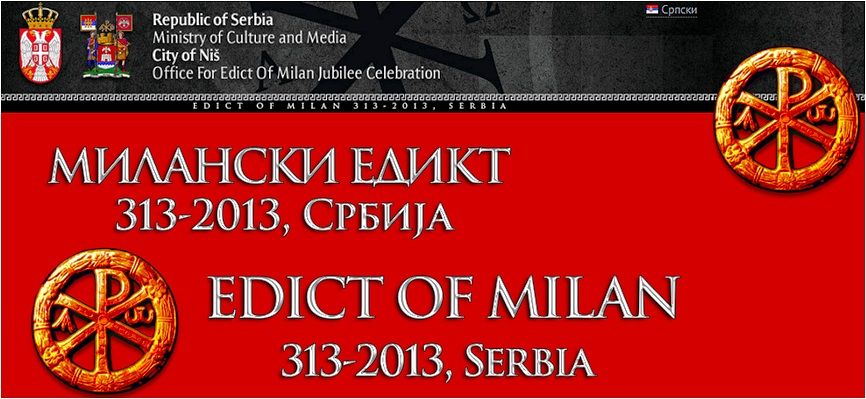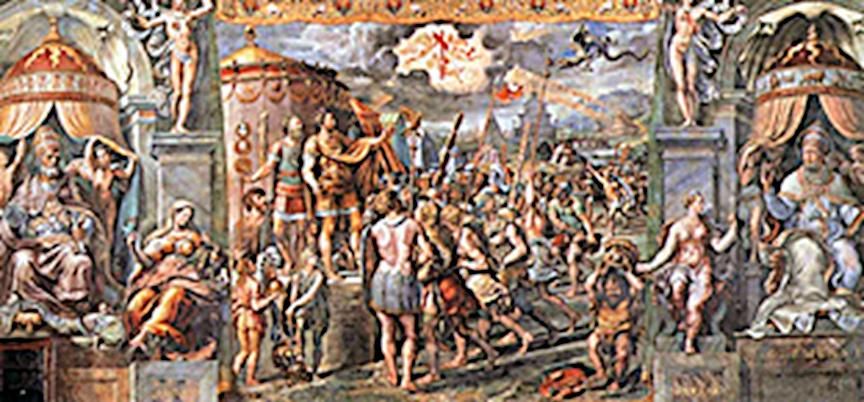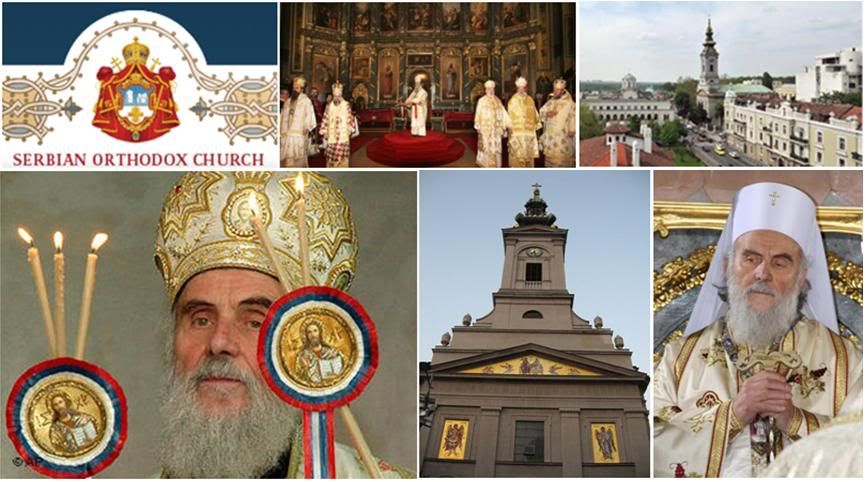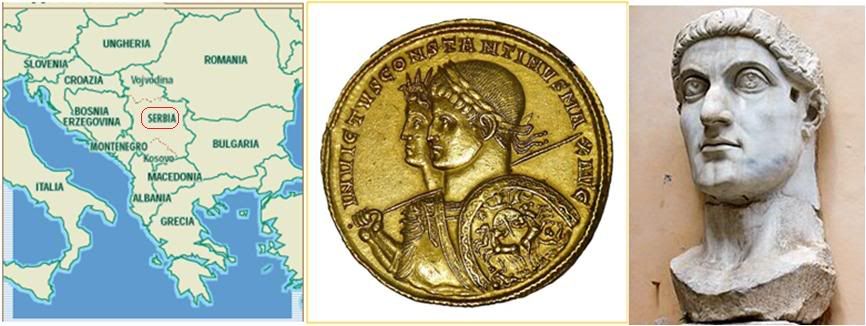 Banner of the Jubilee website of the City of Nis
Christian Jubilee Year marking
Banner of the Jubilee website of the City of Nis
Christian Jubilee Year marking
Constantine's Edict of Milan begins
in Nis, his Serbian birthplace
by Nemanja Cabric

BELGRADE, January 17 - A year-long celebration marking 1,700 years since the Roman Empire granted Christians religious freedom starts today in the Serbian city of Nis, where Roman emperor Constantine the Great was born.
The whole year of 2013 in Nis will be dedicated to the Edict of Milan, a proclamation giving Christianity equal status with other religions in the Roman Empire, led at the time by Constantine the Great.
Nis will thus join the cities of Milan (Italy), York (United Kingdom) and Treves (France) as the key cultural heritage sites connected to Constantine, Rome’s first Christian emperor.
On the opening day of the celebrations a concert of spiritual music performed by the choir of Sretenjski Monastery from Russia wzas to be held at the National Theatre in Nis in the presence of Serbian Orthodox Patriarch Irinej and President Tomislav Nikolic.
Festivities will last until the end of October 2013 and will include both Catholic and Orthodox liturgies, cultural events, lectures and scientific seminars.
The Edict of Milan, which was issued in 313 AD, will be discussed by scientists as well as students and schoolchildren. On June 3rd, known in the Orthodox Church calendar as the Day of the Holy Emperor Constantine, awards for tolerance will be presented.
Constantine’s residence, Mediana, and the Ottoman ‘Skull Tower’ (Celekula), as well as the fortress that dominates the old town of Nis, will feature among the highlights for the growing number of tourists expected in the city.
It’s expected that more than 100,000 believers will join the liturgy to be held by the Catholic Church on September 21st. Because of the large numbers, the organisers are considering whether it might be possible to hold it on the runway of Nis’s Constantine the Great Airport.
It's hard to give a concise history that places the Edict of Milan in the right and total context - or the figure of Donstantine the Great, for that matter = and the best I can do for now is to consolidate previous posts I have made about it that barely skim the scope and significance of Constantine's edict...


 Constantine's story is inseparably linked to his mother, the Empress Helena, whose efforts led to the discovery of the tomb where Jesus was believed to have been buried (over which the Church of the Holy Sepulchre was built) and who brought back relics of the True Cross and, Tradition says, the Holy Robe of Christ, from the Holy Land to Europe. Both Constantine and Helena are considered saints in both the Byzantine and Roman churches.
CONSTANTINE THE GREAT (272-337):
Constantine's story is inseparably linked to his mother, the Empress Helena, whose efforts led to the discovery of the tomb where Jesus was believed to have been buried (over which the Church of the Holy Sepulchre was built) and who brought back relics of the True Cross and, Tradition says, the Holy Robe of Christ, from the Holy Land to Europe. Both Constantine and Helena are considered saints in both the Byzantine and Roman churches.
CONSTANTINE THE GREAT (272-337):
Religion and the State
at the dawn of Europe

 'Visions of the Cross', by the School of Raphael, fresco, 1520-1524, Vatican Apostolic Palace. The central frame depicts Constantine before the Battle of Ponte Milvio )Milvian Bridge) and the cross he saw in the sky with the tag, 'In hoc signo vinces' - By this sign, you will conquer'.
'Visions of the Cross', by the School of Raphael, fresco, 1520-1524, Vatican Apostolic Palace. The central frame depicts Constantine before the Battle of Ponte Milvio )Milvian Bridge) and the cross he saw in the sky with the tag, 'In hoc signo vinces' - By this sign, you will conquer'.
Vatican City, 17 April 2012 (VIS) - "Constantine the Great: The Roots of Europe" is the title of an international academic congress to be held in the Vatican from 18 to 21 April. The event was organised by the Pontifical Committee for Historical Sciences to mark the 1700th anniversary of the battle of Ponte Milvio and the conversion of the Emperor Constantine.
[He would issue the Edict of Milan a few months later. 313 was truly an epochal year for Constantine and the immediate fate of Christianity in the early millennia.]
The congress was presented this morning at a press conference held in the Holy See Press Office, by Fr. Bernard Ardura O. Praem., president of the Pontifical Committee for Historical Sciences; Claire Sotinel, professor of Roman history at the University of Paris-Creteil and a member of the Ecole Francaise in Rome, and Giovanni Maria Vian, director of the "Osservatore Romano" newspaper.
"The conference", Fr. Ardura explained, "is the outcome of effective academic cooperation with important cultural institutions such as the Vatican Secret Archives, the Vatican Apostolic Library, the Italian National Research Council, the Ambrosian Library and the Sacred Heart Catholic University in Milan".
It is also taking place "with the cooperation and contribution of the European Union delegation to the Holy See, the Lazio Regional Council and the Pontifical Lateran University".
This congress is the first of two, the second of which will be held in Milan in 2013 to mark the 1700th anniversary of the promulgation of the Edict of Milan, which established freedom of religion in the Roman empire and put an end to the persecution of certain religious groups, particularly Christians.
While the 2013 congress will concern itself with what is known as the "Constantinian revolution", this year's event will focus on the environment in which Constantine lived and on relations between Christians and the Roman empire prior to the year 313.
Participants will "examine the relationship between religion and the State, the idea of religious freedom in the empire, and religion from the point of view of the emperor and the senate", Fr. Ardura said.
One key area will be the conversion and baptism of Constantine himself, and his attitude towards Christians following the battle of Ponte Milvio, which took place on 28 October 312 and led to the death of his rival Maxentius.
Contemporary and later Christian historians, influenced by the narrative of Eusebius of Cesarea, saw Constantine's victory as the result of divine intervention.
Fr. Ardura pointed out that "from a purely strategic-military viewpoint the battle was not very important, but
it soon became the founding symbol of the new world which came into being when Constantine found Christianity. Indeed ... the era of imperial persecution against Christians was about to come to an end, giving way to the evangelisation of the entire empire and moulding the profile of western Europe and the Balkans; a Europe which gave rise to the values of human dignity, distinction and cooperation between religion and the State, and freedom of conscience, religion and worship."
"Of course these things would need many centuries to come to maturity, but they all existed 'in nuce' (as a seed) in the 'Constantinian revolution' and therefore in the battle of the Milvian Bridge".
For her part, Claire Sotinel explained that attentive and critical historical analysis "facilitates our understanding of what happened following the victory at the Milvian Bridge, helping us in the twenty-first century to reflect on important issues such as the interaction between religions and political power, the creation of religious pluralism, and the possibility of coexistence among different religions".
Now, the Chief Rabbi of Rome
claims that Constantine's conversion
launched anti-Semitism in Europe
by GIacomo Galeazzi
Translated from

Constantine the Great is raising a controversy in Rome, 1700 years since the Roman emperor converted to Christianity under the sign of the Cross.
The Chief Rabbi of Rome, Riccardo Di Segni, claims that "Constantine's conversion changed everything, and had such an impact on history that it is closely linked to anti-Jewish persecution".
But Vatican historians say otherwise. "There was not the least shade of anti-Semitism", saying that a black legend on Constantine continues to be fed today by those "who do not look kindly on the contributions of Christians to the public life".
Di Segni, however, calls Constantine's conversion "an epochal watershed, which divided history into a before and after
[NO! That distinction belongs only to the birth of Christ!] which led to a tragic upheaval that his successor, the Emperor Julian tried to set right, but for which Christians unfairly called him 'the Apostate'.
He adds that to deny the role of Constantine in anti-Jewish persecution was "to go against every available historical evidence", not to mention the question of "his conversion was sincere, or simply a political move".
Jewish persecutions started after the fourth century, said one of the historians participating in the Congress, who also blamed a popular book called Constantine's Sword, by James Carroll, for disseminating historically unfounded data about Constantine and his time.
Giovanni Maria Vian, in his paper, cited a Marxist study by Italian historian Santo Mazzarino who called Constantine " the most revolutionary statesman that Europe had".
Vian says, "Constantine has often been denounced for his autocracy but he was the most tenacious defender of religious freedom", a fallacy that, he says, Paul VI often deplored. Vian says that Constantine advocated "a healthy secularity which remains a model for relations between Italian society and the Church".
Serbian Patriarch wants
to meet Benedict XVI

 Photos taken at Patriarch Irinej's installation rites.
BELGRADE, Jan. 27, 2010 (Translated from ANSA's Balkan service) - Irinej, the new Patriarch of the Serbian Orthodox Church, has reiterated his desire to meet Pope Benedict XVI, saying "the time has come for such a meeting" which could take place in Serbia.
Photos taken at Patriarch Irinej's installation rites.
BELGRADE, Jan. 27, 2010 (Translated from ANSA's Balkan service) - Irinej, the new Patriarch of the Serbian Orthodox Church, has reiterated his desire to meet Pope Benedict XVI, saying "the time has come for such a meeting" which could take place in Serbia.
"In the past, a possible visit by the Bishop of Rome had been discussed, but our position at the time was that the time had not come and we should await the right occasion. Now, I think the time has come," the Patriarch was quoted in the Belgrade newspapers.
"Perhaps it is time that we should tell each other directly what we have to say, and then we can both reflect. Divisions are never positive," he said. "And the division between the Eastern and Western Churches has lasted for centuries".
Thus, he said, a meeting would be indispensable to start examining the outstanding issues. "It is not possible to get to know each other without meeting and talking to each other."
In the days before his election earlier this week to replace Patriarch Pavle, who died last November at age 95, Irinej had said the Serbian Church would like to invite Benedict XVI to visit in 2013 on the 1700th anniversary of the Edict of Milan whereby Emperor Constantine officially recognized Christianity.
 Constantine the Great (272-337) was Roman Emperor from 306 to his death. Center photo, imperial coin from 313; right, head of the so-called Constantine Colossus, a 12-meter high statue of the emperor during his lifetime, now in Rome's Museo Capitolino.
Serbia is celebrating this particularly in Nis, a city of south Serbia where Constantine was born to a Roman soldier and his wife. Irinej was Bishop of Nis until he was elected Patriarch
Constantine the Great (272-337) was Roman Emperor from 306 to his death. Center photo, imperial coin from 313; right, head of the so-called Constantine Colossus, a 12-meter high statue of the emperor during his lifetime, now in Rome's Museo Capitolino.
Serbia is celebrating this particularly in Nis, a city of south Serbia where Constantine was born to a Roman soldier and his wife. Irinej was Bishop of Nis until he was elected Patriarch.
The twist to this story was that in May 2011, the aggresively proactive 'Foreign Minister' of the Moscow Patriarchate, Metropolitan Hilarion, did everything he could to stop the Serbian Patriarch from even thinking of inviting Benedict XVI to Serbia for the 2013 Jubilee.

The city of NIS has a bilingual website on the Jubilee Year at
edictofmilan2013.com/en/ from which I take the following overview:
Considering the all-encompassing significance and the impact of the Edict of Milan on church, state and social life in Europe since the age of Constantine the Great until our time. and its everlasting value and permanent actuality, the Nis City has declared the Year of 2013 the Official Year of Edict of Milan Anniversary Celebration. Events dedicated to the jubilee celebration will last throughout the year of 2013.
In Rome, the most powerful empire of the ancient world, almost three centuries after the birth of Jesus Christ, only 5% of the population was Christian. At that time Constantine was born in Nis. When his reign began, the Empire was pagan. He had visions and dreams in which the Monogram of Christ appeared followed by the words 'In hoc signo vinces" - By this sign, you will conquer - and he did go on to many military victories.
In 313, Constantine and his co-emperor Licinius announced that it was proper that Christians and those who profess other religions should be free to practice the religion that appeared best to each one, thereby officially establishing religious freedom and tolerance throughout the Empire.
The Edict of Milan did not make Christianity the state religion - it made the Roman Empire officially neutral with regard to religious worship, without making paganism, which was widespread, illegal.
The religious freedom instituted for the first time anywhere by the Edict of Milan has particular resonance today when religious freedom is under widespread relentless assault, as never before in modern times, from the United States and Western Europe, to the countries of the false 'Arab spring', the Muslim countries of the Middle East, South Asia and Indonesia; and the Communist holdouts China, North Korea and Cuba..
[Modificato da TERESA BENEDETTA 18/01/2013 17:17]